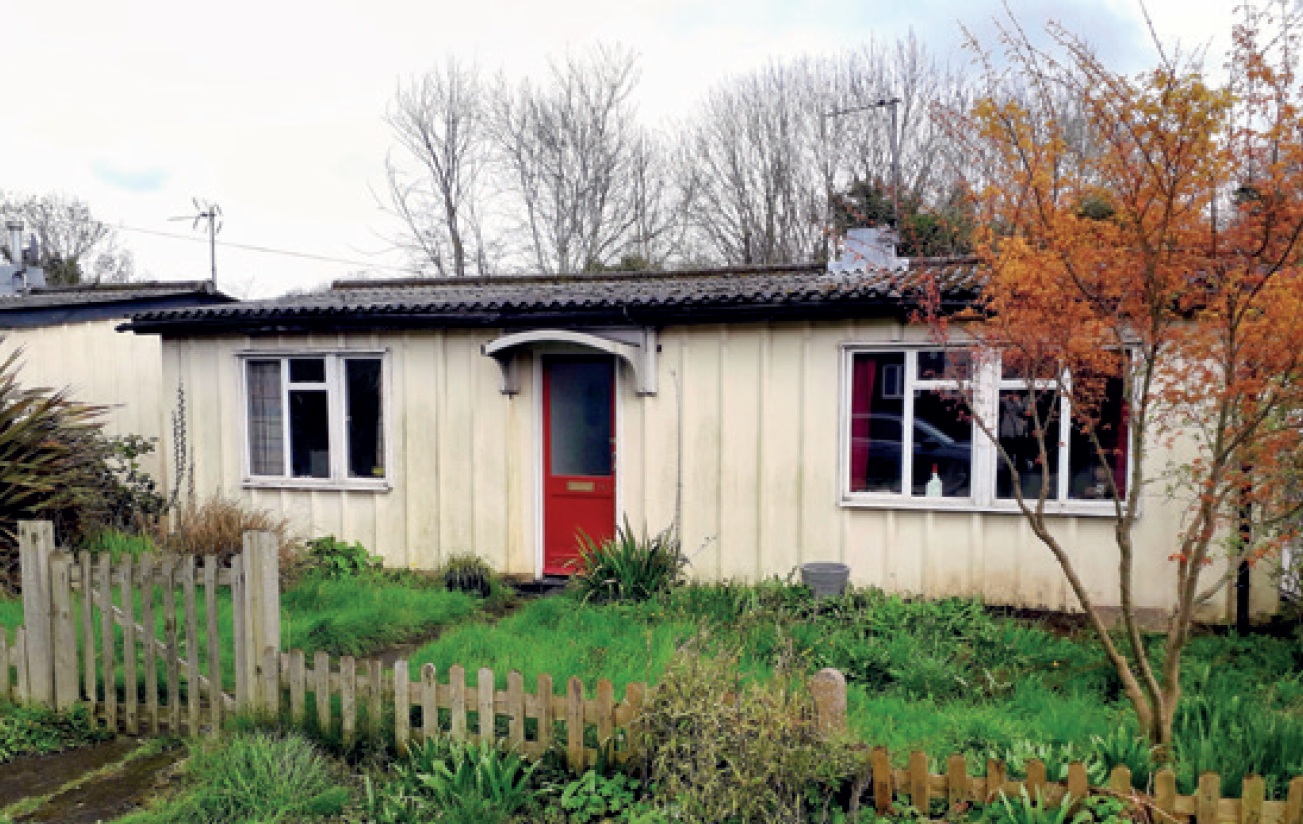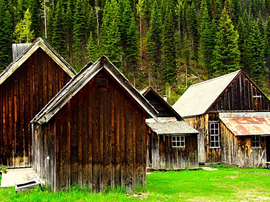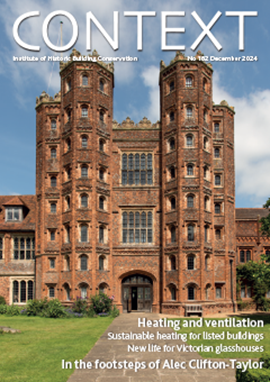Prefabs at Wake Green Road in Moseley
The conservation of a row of Grade II-listed prefabs at Wake Green Road in Moseley, Birmingham, highlights the challenges of dealing with this popular type of housing.

|
| The Phoenix was a rare type of prefab, only 2,428 being erected nationwide. (Photo by Katriona Byrne). |
Prefabs seem to have an appeal that is universal. Architecture without architects, yet highly designed, cottages based on advanced technology, small yet roomy, simple but clever, built with unskilled labour on leftover land, imbued with the hopes and dreams of their first occupants, and carrying the nostalgia and memories of subsequent residents and passersby, national narratives made local, a perfect blend of the tangible and intangible. This article looks at the current conservation of a row of them in Birmingham.
The 16 prefabs at Wake Green Road in a southern suburb of Birmingham were built in 1945, to the Phoenix design. This was one of a number of design options applied to the challenge of creating a two-roomed bungalow with an inbuilt unit of kitchen and bathroom. The Ministry of Works held a competition, and an innovative housing unit called the ‘Portal’, or ‘Portal’s Palace’, named after the minister, Lord Portal, was the result. Its core was a heating and water unit, flanked by a bathroom on one side and a kitchen on the other, with two bedrooms to the left of the front hall and a living room to the right. Many wartime industries proposed their own designs for the standard size, switching their existing processes and materials from military to peacetime endeavours. Eleven types were approved. In total, about 156,623 bungalows were built in the country between 1945 and 1949.
A prototype cottage went on display in the Tate Gallery in May 1944, welcoming thousands of visitors. They marvelled at the indoor bathroom, running hot water, central heating, fitted kitchen (with washing machine, cooker and refrigerator) and inbuilt furniture. This was the height of modernity at the time, and luxury in the face of the scarcity of materials and furniture.
Local authorities were required to order units and identify land where they could be assembled to house people made homeless by the bombing and to accelerate house building programmes. The houses were not cheap by any means, but they were quick to assemble and they were funded by central government under the Housing (Temporary Accommodation) Act 1944. Birmingham City Council said that it would take so many units of certain types, but in the end had little choice and was instructed instead to take different ones. The Phoenix was a rare type: only 2,428 were erected in the country. The local authority built the foundations and waited for delivery. Local labour erected the walls and roofs around the preassembled kitchen/bathroom unit. Newspapers reported that prisoners of war were among those working on them.
Interest in them today means that there are multiple theses on them from the postgraduate course I run alone, and the fabulous Prefab Museum (www.prefabmuseum.uk) celebrates Britain’s post-war prefabs and their residents. This online museum and archive does mapping work that shows the types of plots where the prefabs were installed, and these can sometimes be identified even after the prefabs have been replaced. The homes were intended to last for 10–15 years, and while many lasted much longer, most have been swept away. Those in Birmingham are some of the only survivors and were listed at Grade II in 1998. Other listed prefabs are six Uni-Seco types on the Excalibur Estate, Persant Road, London, from 1945–6, and a Swedish semi-detached pair from 1948 in Ellers Lane, Doncaster. There is a fantastic example of an Arcon Mark V type in the Avoncroft Museum of Historic Buildings in Bromsgrove. It came from Yardley, Birmingham, completely furnished in 1940s style, with a reproduction garden and an Anderson air-raid shelter. St Fagan’s National Museum in Wales has an AIROH type.
From 2016 to 2019, the Birmingham prefabs were opened by Birmingham City Council’s housing department during Heritage Week, when the Birmingham Conservation Trust hosted a series of activities aided by the Prefab Museum. As one of the volunteers, I was blown away by the diversity of people visiting them (far more diverse than seen in most heritage sites), by the memories and stories people brought with them, by their utter fascination with them and by their appreciation for what they were. Guides demonstrated the ingenious systems of inbuilt furniture, sometimes serving dual rooms: a wardrobe in a bedroom and a cupboard in the hall, a recessed shelf in the kitchen over a shelf in the bathroom. Items of surviving lino, wallpaper, fireplaces, hearths, and even rent books and electricity dockets were pored over.
I first saw the homes in 2014 when inspecting for Historic England and resisted a proposal for their demolition. They were gradually becoming at risk, with a number being vacant. A feasibility study, funded by Historic England in 2017, identified that the best use for them was to remain as housing for the council, with perhaps one or two made accessible as a museum for a trust and another as a potential Airbnb, capitalising on their potential retro appeal. No solution came forward, though, and the council embarked on planning for their renovation. It was always going to be challenging.
The main issues were the corrugated asbestos-cement exterior walls and roofs, and the failure of the concrete floors in various ways. It was considered important that the frames were not disassembled because of the high degree of loss that would entail. Instead, a solution was pursued to renew the floors and foundations while the frame stayed in place. Examples of this was renovation work done at Croome Court for the National Trust, underpinning concrete floors of temporary military buildings. Other parts of the structures at Wake Green Road included the steel tubular poles at the corners and at intervals, holding a frame to which the asbestos cement was attached. The windows had already been replaced with double-glazed units.
Conservation of the units began on a pilot basis in 2023. A number of vacant units were worked on to test systems, the theory being that they could be available to people who would move into them when their own houses were being renovated. The interiors were stripped out, with original fittings put in storage; external walls were underpinned using resin injection; traditional concrete foundations were laid along the central spine walls; and new insulated concrete floors were cast.
Drawings existed that were a good guide to some of the construction detailing. Puzzles such as the original design of the canopy over the front doors, of the front doors themselves and of the garden shed were solved. However, the original design of the garden fence was not identified.
Significance lies not only in the form and structure but also in the fittings. A single dado rail, or a shelf made of plywood, can be unvalued and lack people to repair them, but they can make such a big difference to what, for better or worse, we might call authenticity, or the sense of the direct relationship of people today to the past. The resident of one of the most intact prefabs was reluctant to allow their house to be renovated, fearing the loss of the small details of lino and tiles and the separate bathroom and toilet, survivals all bound up with the love of their parents for the home. This meant a house that was almost a museum. Seeing the fate of the others inspired them to go for the renewal, but with much trepidation.
I found it hard to advise this person, during a visit to the site, because fundamentally it is right to be afraid of the damage that works bring. The listing description reminds us of what is at stake, calling the group of prefabs ‘still more remarkable for its exceptional state of preservation with few alterations.’ Water ingress through the front eaves, though, brought about the capitulation.
There was always a dilemma over the years with these prefabs about whether to translocate small remnants to concentrate them in one or two of the more intact units, or to reinstate everything where it came from. At every level of the renovation the impact of works was a concern: that the correct degree of recording was conditioned by planning and listed building consent; that the right contractor was appointed; and that the right processes were in place to safeguard things found during works. The foreman expressed the need to identify the right workers for the different parts of the job so that adequate care was taken. Specialist joiners were introduced in response to some persistent losses.
From my own view, as an outsider, the need to completely take down the central spine wall and rebuild it was regrettable, if not unduly harmful. The need for increased insulation to roof and walls was always acknowledged, and the generous spaces of the rooms facilitated this. However, insistence on current standards for all housing stock meant that the degree of insulation affected the retention of some inbuilt furniture which had to be modified, which was a risk in itself. The retention of the old, double-glazed windows was pragmatic. For me, the compromises seem worth it. The ultimate test, though, is what the resident of the museum-state prefab thinks.
This article originally appeared as ‘A pocket of prefab fabulousness’ in the Institute of Historic Building Conservation’s (IHBC’s) Context 181, published in September 2024. It was written by Katriona Byrne, a conservation officer by profession, deputy head of the Birmingham School of Architecture and Design and course director of the MA and postgraduate programmes in conservation of the historic environment at Birmingham City University.
--Institute of Historic Building Conservation
Related articles on Designing Buildings Conservation.
IHBC NewsBlog
IHBC Annual School 2025 - Shrewsbury 12-14 June
Themed Heritage in Context – Value: Plan: Change, join in-person or online.
200th Anniversary Celebration of the Modern Railway Planned
The Stockton & Darlington Railway opened on September 27, 1825.
Competence Framework Launched for Sustainability in the Built Environment
The Construction Industry Council (CIC) and the Edge have jointly published the framework.
Historic England Launches Wellbeing Strategy for Heritage
Whether through visiting, volunteering, learning or creative practice, engaging with heritage can strengthen confidence, resilience, hope and social connections.
National Trust for Canada’s Review of 2024
Great Saves & Worst Losses Highlighted
IHBC's SelfStarter Website Undergoes Refresh
New updates and resources for emerging conservation professionals.
‘Behind the Scenes’ podcast on St. Pauls Cathedral Published
Experience the inside track on one of the world’s best known places of worship and visitor attractions.
National Audit Office (NAO) says Government building maintenance backlog is at least £49 billion
The public spending watchdog will need to consider the best way to manage its assets to bring property condition to a satisfactory level.
IHBC Publishes C182 focused on Heating and Ventilation
The latest issue of Context explores sustainable heating for listed buildings and more.
Notre-Dame Cathedral of Paris reopening: 7-8 December
The reopening is in time for Christmas 2025.
















